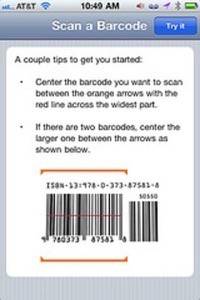This morning, eBay announced its recently acquired mobile barcode scanning application Red Laser will now support QR Codes, also known as 2D barcodes. In addition, the updated version of the price comparison shopping app, available now in the iTunes App Store, will also incorporate eBay Marketplace and Half.com listings in its product results section.

This news comes on the heels of another big-name barcode scanning app update: Amazon Mobile. Only yesterday, Amazon announced its mobile application would now offer barcode scanning.
Is a barcode scanning battle brewing?
eBay Updates Red Laser and Accompanying Developer Tools
Occipital’s Red Laser was one of the first iPhone applications to become popular with barcode scanning early adopters, which led to its acquisition by eBay in June of this year. At the time of purchase, it had already been download over two million times. The app allows customers to use their phone to scan barcodes of products on store shelves in order to receive price comparisons from a database of merchants.

But eBay wasn’t just after the app – Occipital had also licensed its technology to a network of then some 70 or so companies. In June, is was unclear how the eBay acquisition would affect these licensing agreements. But today, eBay makes that more clear: its now updating its RedLaser SDK (software development kit – the tools third-party developers use to build on top of Red Laser’s technology). The new SDK is now in the hands of 100 third-party developers including household name Coupons.com. The updated SDK will include support for VIN barcode scanning, Code 128 for gift card scanning and Code 39 for encoding uppercase letters A through Z, digits 0 through 9 and other special characters.
While those technical details may not mean much to end users, what it signals to developers is that eBay is not letting this acquisition stagnate. In fact, eBay claims that its goal is to become “the de facto application for product search and scanning.”
Amazon Rolls Out Barcode Scanning, Too
Of course, that’s a claim Amazon.com would like to make as well. The latest version of its Amazon for iPhone application was just updated yesterday to include a barcode-scanning feature. Before, the app let you search by keyword, by browsing product recommendations or by snapping a photo of the item.
With Amazon’s new barcode-scanning technology, it’s not so much of a global price comparison engine but one that answers the simple question: “I wonder if this is cheaper on Amazon?” If the product scanned is, indeed, cheaper online, you can buy it right from the mobile application itself.

As with eBay’s Red Laser, the idea behind Amazon’s app is to offer the online retailers a way to compete with brick-and-mortar stores even more directly than they are already doing now. Customers can still enjoy the hands-on – and in some cases recreational – experience of shopping, but get to save money, too. For retailers big and small, the rise of the barcode scanners is a challenge they’ll have to meet head-on with competitive pricing, price-matching and other offers and incentives in order to retain their most penny-pinching customers. And given today’s economy, that’s nearly every shopper.
This Industry is Blowing Up
Barcode scanning is a rapidly growing market. According to new data from industry leader ScanLife, the use of barcode scanners is up 700% in 2010.
Electronics dealer Best Buy is also investing in this space, as it itself is often a target of barcode-enabled thriftiness. It recently launched its own price comparison app Tecca.
The technology isn’t just limited to straight up price comparison apps, either.
makes scanning a game and new location-based apps
and
reward customers for scanning products in stores.
meanwhile lets you tag real-world objects with barcoded stickers for a sort of “
” experience.









